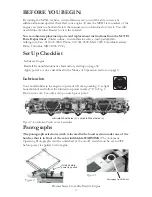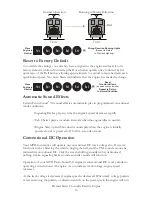
Automatic Operating Pantographs
Your MTH electric type engine is equipped with Automatic Operating Pantographs. The
Automatic Operating Pantographs must be unlatched before power is applied to the
engine. To unlatch the pantographs, hold the base of the pantograph and gently pull up
on the contact slider.
The rear pantograph should open to its full height. The front pantograph should rise
slightly to unlatch, but remain collapsed.
Power Selection
The Automatic Operating Pantographs can be used to obtain power from an overhead
cantenary system. In order to obtain power from an operating overhead cantenary move
the selector switch from the track position to the pantograph position as shown in
figure 4.
To insure good conductivity of the pantograph, the blackening on the top of the
contact slide should be removed. This can accomplished by running the engine while
using the pickup rollers with the pantographs raised or by using a track cleaning pad.
Pantograph/Track
Position Switch
Figure 4: Pantograph/Track Position Switch
Conventional Mode
When power is applied in conventional mode the pantographs will go through an
orientation check. This will make sure that the rear pantograph is raised and the front
pantograph is lowered.
When the direction of the locomotive is reversed the front pantograph will rise, then
the rear pantograph will lower. This is to insure that at least one of the pantographs is
in contact with the cantenary at all times. This action takes place in the neutral state.
When the engine is moving, the trailing pantograph on the engine should be up and the
leading pantograph should be down.
The pantographs will alternately rise and lower with each direction change of the
locomotive.
Premier Swiss Crocodile Electric Engine
4




































